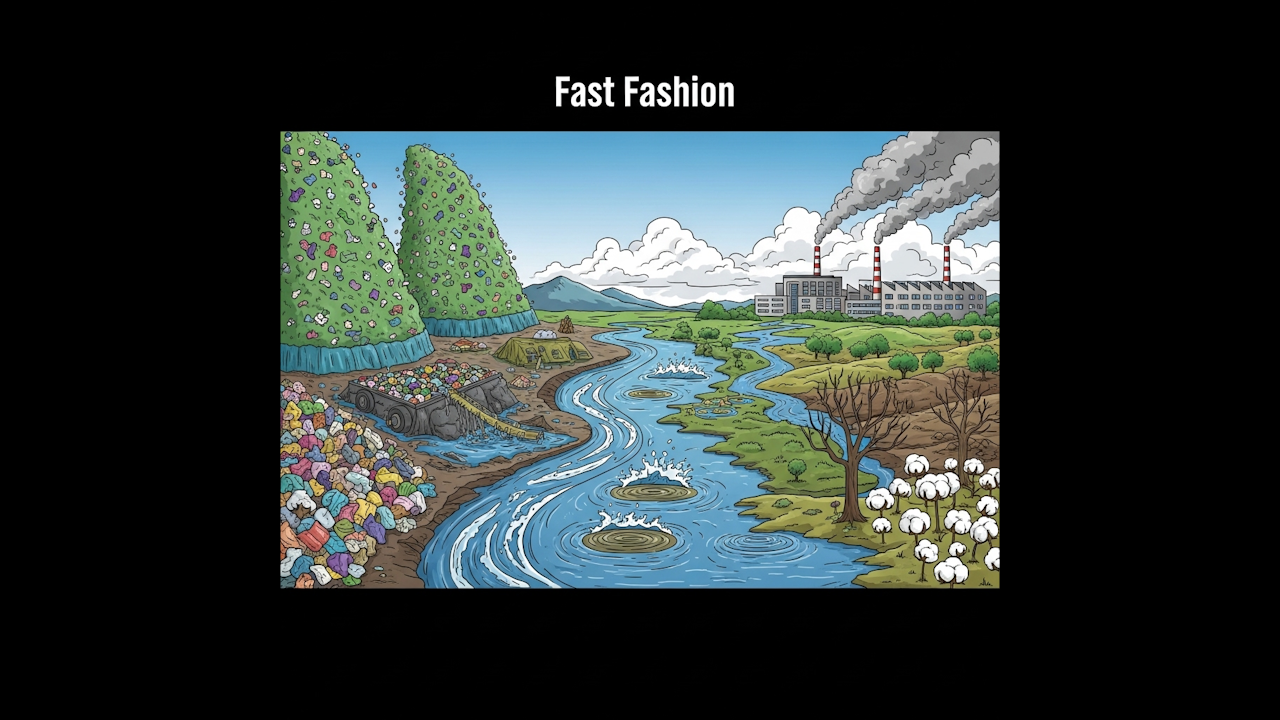Fast fashion has revolutionized the way consumers interact with clothing. With rapid production cycles, low prices, and constantly changing trends, it encourages frequent purchases and disposability. However, behind the glossy storefronts and enticing advertisements lies a deeply unsustainable system. The environmental toll of fast fashion is vast, affecting natural resources, polluting ecosystems, and contributing significantly to climate change.
The fashion industry is currently one of the most resource-intensive sectors in the world. It takes approximately 2,700 liters of water to produce a single cotton shirt — enough water for one person to drink for two and a half years. Multiply that by the billions of garments manufactured each year, and the strain on freshwater resources becomes alarming. Cotton, a staple material in clothing, is heavily dependent on pesticides and water, particularly in regions already suffering from drought or limited clean water supplies. As demand increases, so too does the environmental burden.
Beyond water usage, the carbon footprint of fast fashion is considerable. The industry accounts for an estimated 10% of global carbon emissions — more than international flights and maritime shipping combined. Synthetic fibers such as polyester, which are made from fossil fuels, are commonly used in fast fashion garments due to their low cost and versatility. Polyester takes hundreds of years to decompose and releases microplastics into waterways each time it is washed, polluting oceans and entering the food chain. As more garments are made from such materials, the scale of pollution intensifies.
Another significant issue is textile waste. Fast fashion thrives on obsolescence; styles shift weekly, pressuring consumers to discard clothing long before it wears out. Globally, it is estimated that one garbage truck full of textiles is landfilled or burned every second. These discarded garments, often made with synthetic materials, do not break down easily and release harmful chemicals into the soil and air as they degrade. Many clothing donations to thrift stores or charities are never reused. Instead, they are shipped to developing countries, where they can overwhelm local economies or end up in landfills there.
The dyeing and finishing processes in garment production are also harmful to the environment. Textile dyeing is the second-largest polluter of water globally, with toxic chemicals and dyes often being dumped into rivers and lakes, particularly in countries with lax environmental regulations. This practice affects aquatic life and the health of communities that rely on these water sources for drinking, cooking, and farming. The rivers near garment factories in parts of China, India, and Bangladesh often run with unnatural colors and are devoid of life.
Land degradation is another often overlooked consequence. To meet the rising demand for natural fibers like cotton, vast areas of land are cleared and over-cultivated. This leads to soil exhaustion, deforestation, and biodiversity loss. The monoculture farming practices used in large-scale cotton production reduce the resilience of ecosystems, making them more vulnerable to pests and diseases and further increasing the need for chemical inputs.
In addition to environmental damage, fast fashion has a social dimension that exacerbates its ecological impact. Many factories in low-income countries operate with minimal regulation, exploiting laborers who work long hours for meager wages. Poor working conditions and lack of environmental safeguards mean that both people and nature pay the price for cheap clothing. Toxic exposure, inadequate waste management, and unsafe buildings are common in these facilities. When fashion is driven purely by profit and speed, ethical considerations and sustainable practices fall by the wayside.
The transportation of fast fashion items from production sites in Asia or South America to markets in North America and Europe also contributes to environmental degradation. These goods are shipped thousands of miles, often using carbon-intensive modes of transport. Fast turnaround times mean reliance on air freight in some cases, which carries a significantly higher carbon cost than sea freight.
While the challenges posed by fast fashion are extensive, awareness and action are beginning to take root. Consumers are increasingly questioning the ethics and sustainability of their purchases. Movements promoting second-hand clothing, clothing swaps, and capsule wardrobes are gaining traction. More companies are exploring eco-friendly fabrics, such as organic cotton, bamboo, and recycled materials. Innovations in textile recycling are also emerging, aiming to reduce waste and extend the life of garments.
However, meaningful change requires more than individual action. Systemic shifts in how fashion is produced, consumed, and disposed of are necessary. Governments and international organizations must implement stricter environmental regulations, enforce labor protections, and support sustainable fashion initiatives. Brands must take responsibility for the full life cycle of their products, from design to disposal. Investment in circular economy models — where products are designed to be reused, repaired, or recycled — is key to reducing the industry’s footprint.
In the end, the fast fashion industry presents a stark choice between convenience and sustainability. The planet can no longer absorb the consequences of unchecked consumption and waste. As consumers, producers, and policymakers begin to rethink their relationship with fashion, there is potential to reshape the industry into one that respects both people and the planet.

